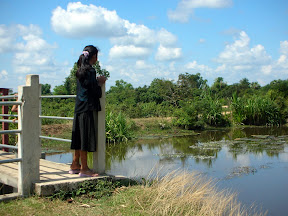Some words I had never hoped to learn in Khmer: diarrhea, nausea, fever, landmine, leech, amputation, etc.
We had already been there two weeks by the time we all got sick. We were working fourteen hour days, boring holes in the ground, mapping the site with makeshift surveying tools, and building scientific equipment out of garbage pails, garden hose, kitchen implements, and bamboo. We negotiated prices at the Old Market hardware shops, bartered cigarettes for rope with the CMAC crew, and charmed a lower price out of a gravel saleswoman. She invited us into her home, poured us some cold water, sat us on the couch where she was watching a kung fu movie on the tube, and we talked for a few minutes before closing the deal. Two big bags for a few bucks. At the job site, we'd toil all day in the equator sun, breaking for fruit and bread lunch around 3:00. When we got back to Siem Reap we'd run some tests on our soil samples in the lab we'd assembled on the front porch. Then, after two hour long debriefing meetings, we wouldn't have the energy to eat dinner.

We were in Cambodia for a few weeks to perform some basic engineering tests before repairing the old Trau Kot dam. The dam was part of a major agricultural project by the Khmer Rouge, an earthen embankment built to store water from the rainy season for irrigation during the dry season. A huge section of the old dirt mound had washed away, and we were working to rebuild it in concrete. It was sometimes difficult finding information about the dam's history. Our host's cook had spent years there, forced to work for the KR, and she refused to talk about it at all. Workers were promised rice for their labor, but Ankar had food enough for less than half of the forced laborers. Work was directed by teenage children with guns, and labor was performed by adults. Work animals were well fed while people starved. The educated were despised, and any worker with knowledge enough to recognize the technical errors of the dam would be killed for speaking up. During the KR regime, millions of people were forced out of their city homes, separated from their families, and forced to work in the fields. Two million people were killed. This happened in my own lifetime.
The first day at the dam, we found a few spent AK-47 shells. Bullets were used sparingly by the poorly funded Khmer Rouge regime, and as I stared at the rusty casing in my hand I knew what this one was used for. And if these shells were lying on the ground, it meant we were stepping outside of the zone that had been cleared by the Cambodia Mine Action Committee. We tiptoed back to the oxcart path. The landmine clearing operation was making much progress, and our daily trips to the isolated dam site at Balang Commune were becoming less dangerous by the day.
After dusk, our driver brought us back from the project site, winding through unlit dirt roads, passing oxcarts loaded with timber, a few small motorbikes, and occasionally a smiling, waving child standing at the side of the road. The extreme poverty of the region takes hold at night, when workers return home to their small huts with no electricity or running water. We passed by a hut with a flickering blue light inside. This family had saved enough money to buy a television, powered by car battery. Soon they'd get tired, turn off the tube, roll out a mat on the floor, and go to sleep. They were stuck there, sleeping with the mosquito borne dengue and malaria, the rats, roaches, massive spiders, all the things we were escaping from each night, haunting them, stalking them, slowly enveloping them like a suffocating blanket. It's a jungle, and day by day it moves a little closer to swallowing you if you let it.
Yet in the daylight it's the genuine smile on the face of every stranger that is most engaging, directed, beaming through the dusty roads, and buried within it the pure joy of life, persistence, perseverance.




